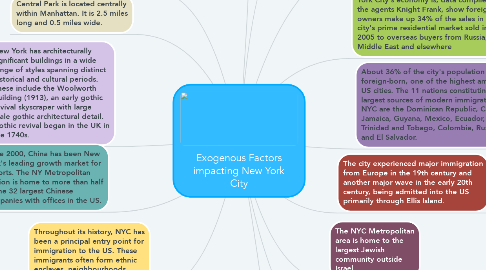Exogenous Factors impacting New York City
von Lucy Stephenson-Brown

1. There are 2 main rivers that run through NYC: the Hudson in the east (the mouth is the Atlantic Ocean) and the Delaware to the west
2. New York Harbor and the Port of NY are on Staten Island. They are the largest oil importing dock in the USA.
3. Central Park is located centrally within Manhattan. It is 2.5 miles long and 0.5 miles wide.
4. New York has architecturally significant buildings in a wide range of styles spanning distinct historical and cultural periods. These include the Woolworth Building (1913), an early gothic revival skyscraper with large scale gothic architectural detail. Gothic revival began in the UK in the 1740s.
5. Since 2000, China has been New York's leading growth market for exports. The NY Metropolitan Region is home to more than half of the 32 largest Chinese companies with offices in the US.
6. Throughout its history, NYC has been a principal entry point for immigration to the US. These immigrants often form ethnic enclaves, neighbourhoods dominated by one ethnicity.
7. One out of every ten private sector jobs in the city is with a foreign company. Since 2000, China has been NY's leading growth market for exports. The NY Metropolitan region is home to more than half of the 32 largest Chinese companies with offices in the US. These companies represent a broad array of industries including shipping, steel, energy and manufacturing firms and services. Many have chosen to open headquarters in New York in anticipation if eventual listing on the respective NY stock exchanges and entering US capital markets.
8. The CBD of New York is located in mid-town Manhattan- this is where 5th Avenue, Times Square, the Rockefeller Centre etc are located. Rent in Times Square can be upwards of $42 million per year.
9. NYC has 2 airports- LaGuardia in Queens and John F Kennedy airport in Brooklyn.
10. NYC is at its flattest by the ocean and as you move more inland there are gentle rolling hills (Manhattan is Indian for 'Island of many hills')
11. In one measure of how international New York City's economy is, data compiled by the agents Knight Frank, show foreign owners make up 34% of the sales in the city's prime residential market sold in 2005 to overseas buyers from Russia, the Middle East and elsewhere
12. About 36% of the city's population is foreign-born, one of the highest among US cities. The 11 nations constituting the largest sources of modern immigration to NYC are the Dominican Republic, China, Jamaica, Guyana, Mexico, Ecuador, Haiti, Trinidad and Tobago, Colombia, Russia and El Salvador.
13. The city experienced major immigration from Europe in the 19th century and another major wave in the early 20th century, being admitted into the US primarily through Ellis Island.
14. The NYC Metropolitan area is home to the largest Jewish community outside Israel.


